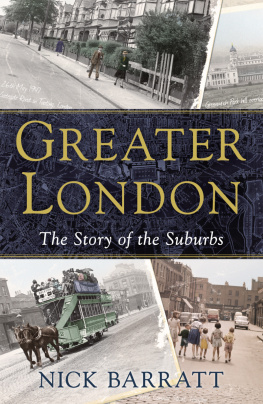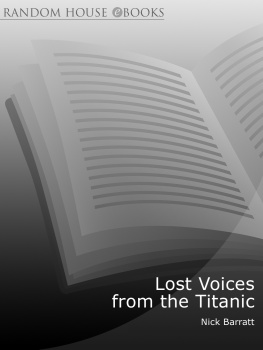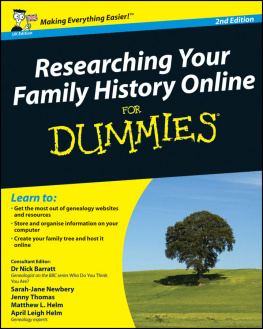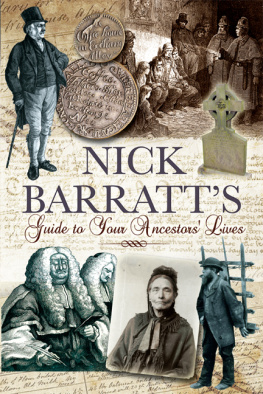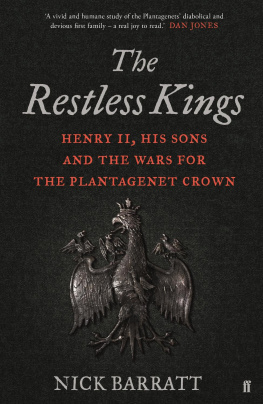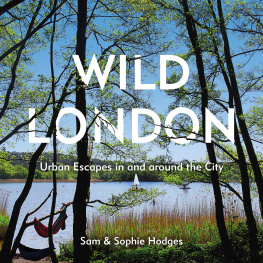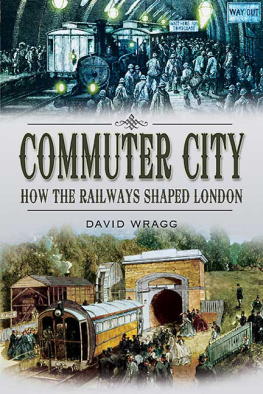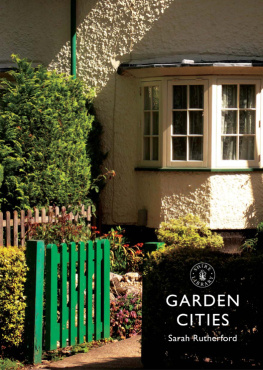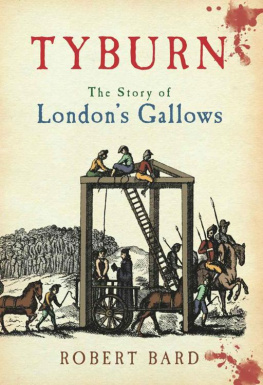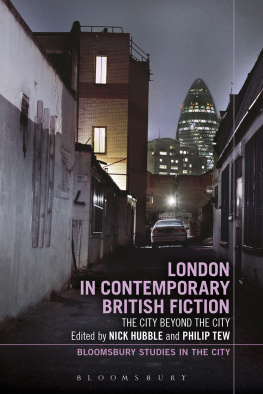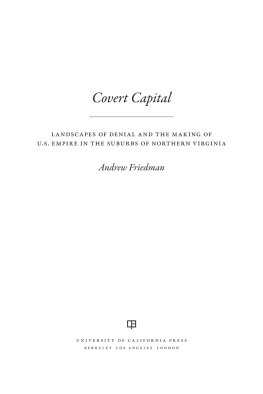CONTENTS
About the Book
Londons suburbs may stretch for well over 600 square miles, but in historical accounts of the capital they tend to take something of a back seat. In Greater London, historian Nick Barratt places them firmly centre stage, tracing their journey from hamlets and villages far out in the open countryside to fully fledged urban enclaves, simultaneously demonstrating the crucial role they have played in the creation of todays metropolis.
Starting in the first century AD, he shows how the tiny settlements that grew up in the Thames Valley gradually developed, and how they were shaped by their proximity to the city. He describes the spread of the first suburbs beyond the city walls, and traces the ebb and flow of population as people moved in to find jobs or away to escape Londons noise and bustle. He charts the transformation wrought by the coming of the railways, the fight to preserve Hampstead Heath, Epping Forest and other green spaces, and the struggle to create a London-wide form of government. He gives an account of wartime destruction and peacetime reconstruction, and then brings the story to the present with a description of the very varied nature of todays suburbs and their inhabitants. In the process, he evokes Tudor Hackney and Georgian Hampton, explains why Victorian Battersea and Finchley were so different from one another, and follows Islingtons fall from grace and subsequent recovery.
Magnificently illustrated throughout with contemporary engravings and photographs, this is the essential history for anyone who has ever lived in London.
About the Author
DR NICK BARRATT obtained a PhD in history from Kings College London in 1996 and then went on to become a specialist archive researcher at the BBC. He is now a presenter, reviewer and commentator on all aspects of history, with a particular interest in the medieval period and family history. He is currently CEO of SRA (Sticks Research Agency), which he founded in 2000.
Greater London
The Story of the Suburbs
Nick Barratt

INTRODUCTION
It was while I was flying into London from Edinburgh, having just delivered a talk in Dundee the night before, that I was really struck for the first time by the sheer awesome scale of the city I call home. The plane was taking a route over the centre of London and towards Heathrow Airport, following the meandering path of the River Thames. It was easy enough to spot the central landmarks skyscrapers, tourist attractions and railway termini but as we flew over them I could see that the heart of London, seemingly so large when you cross it on foot, was completely dwarfed by the sprawl of the suburbs that embrace and encircle it. As far as the eye could see there stretched a dense swirl of terraces and housing estates, roads and railways, occasionally dotted with the green of a park or common.
Of course, I had always known that London was vast, but what brought the realisation so forcefully home to me on this particular occasion was the mental comparison I found myself making between the capital city I had just left behind and the one I was returning to. Edinburgh is not exactly negligible in scale, with its historic heart, its suburbs and its half-million inhabitants; but its also clearly defined and contained. From the air at least, London seems to have no beginning and no end.
The aim of this book is both to explain how London got that way and to celebrate the suburbs that now dwarf its historic centre. However, I had better make two disclaimers at the outset. First of all, this is a history of the suburbs and the capitals relationship with them, not a broadly based history of London. London has been astonishingly fortunate in its biographers from John Stow in the sixteenth century through to Peter Ackroyd more recently. Jerry White has written a brilliant trilogy about the capitals history from Georgian times to the present, Many other historians and chroniclers have made invaluable contributions. I do not see the need to add to this weightily impressive body of literature.
Secondly, what follows is not a detailed history of each of Londons suburbs. Tempting though it is, given their rich histories, to give a blow-by-blow account of the rise of Ealing, Hackney, Tottenham or Streatham, there is a real danger that not only would the resulting volume be impossibly bulky but it might well also be impenetrable. Instead I have set out to trace the steps by which a small settlement in the south-east corner of England became so vital to the national economy that it started to draw surrounding satellite towns and hinterland into its orbit, like a black hole sucking in planets and stars, and I have tried to explain how those satellite areas were transformed as a result. In the process, I have sought to explore various recurrent themes: the complicated relationship between central London, which supplied the jobs, and the outer areas which in the early days provided the centre with much of its food and vital supplies and, later on, with much of its workforce; the appeal of the suburbs as a place of refuge from the noise and bustle of inner London; the eastward pull of industry and the westward pull of wealth; the transformation wrought by changes to the capitals transport; the gradual exodus from central London to the suburbs from late Victorian times and the recovery of the inner suburbs more recently. I have also explored the ways in which generations of Londoners have struggled with the concept of London and the long and bitter battle to establish a form of government that encompassed the capitals physical sprawl. To give a sense of how these broader themes have played out at a local level I have tried to include as many specific examples as possible, looking, for instance, at how Battersea developed in Victorian times and why Gospel Oak looks the way it does today.
I should also mention that what I mean by suburbs is all of London that lies beyond the old City walls, that connects it with its twin city Westminster, and that surrounds both. In other words, I have chosen to interpret the word in its most literal and historical sense. It may seem strange to be asked to consider Covent Garden or Piccadilly as suburbs, but, of course, in their time they were and it is only as London has grown ever vaster that they have come to seem an inextricable part of its original self.
London started to spill beyond its walls in the eleventh century, and very soon its chroniclers were taking an interest in what was happening beyond the City limits. Writing in the twelfth century, for example, William fitz Stephen observed:
Also up-stream to the West the Royal Palace rises high above the river, a building beyond compare, with an outwork of bastions, two miles from the City and joined thereto by a populous suburb. On all sides, beyond the houses, lie the gardens of the citizens that dwell in the suburbs, planted with trees, spacious and far, adjoining one another... There are also round about London in the Suburbs most excellent wells... among these Holywell, Clerkenwell and Saint Clements Well are most famous.
This description, brief as it is, nicely flags up those elements of the suburbs that made them so attractive to Londoners: as a source of the essentials of life, such as food and water, and as a quiet retreat from the hustle and bustle of a cramped and often filthy city. Over time, as London spilled ever further beyond its ancient boundaries and towards the separate entity of Westminster, so new chroniclers recorded the capitals expansion. The diary of Henry Machyn, citizen and merchant-taylor of London, noted many of the developments that took place during the reigns of Edward VI, Mary and early Elizabeth I. in which he explored the way in which the suburbs were continuing to march inexorably away from the City walls:
Next page
